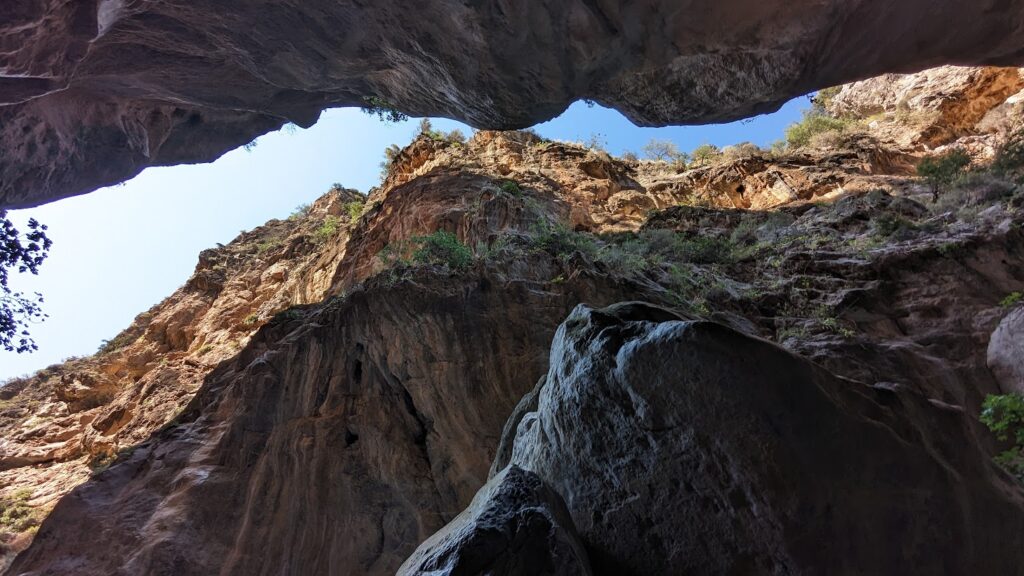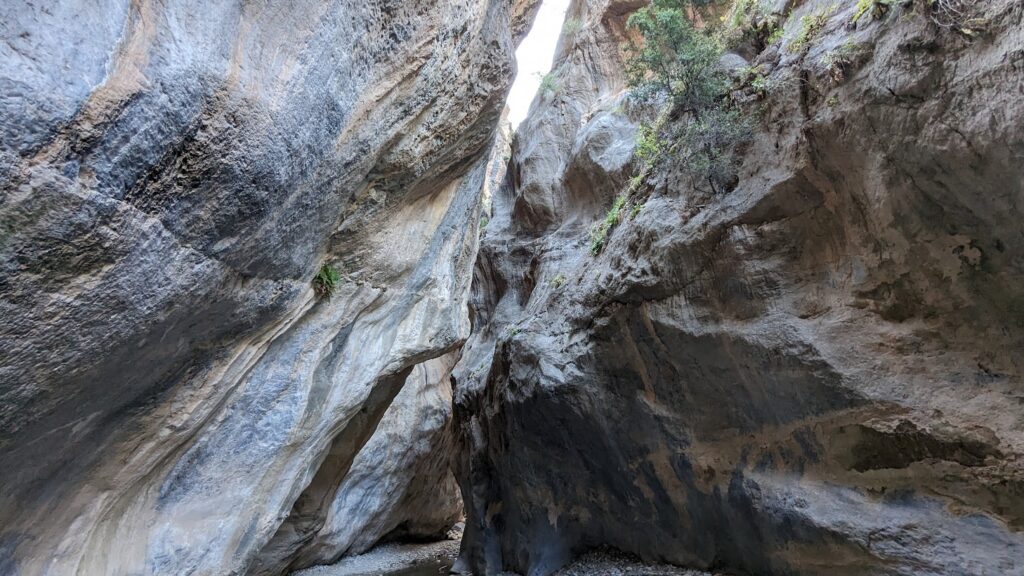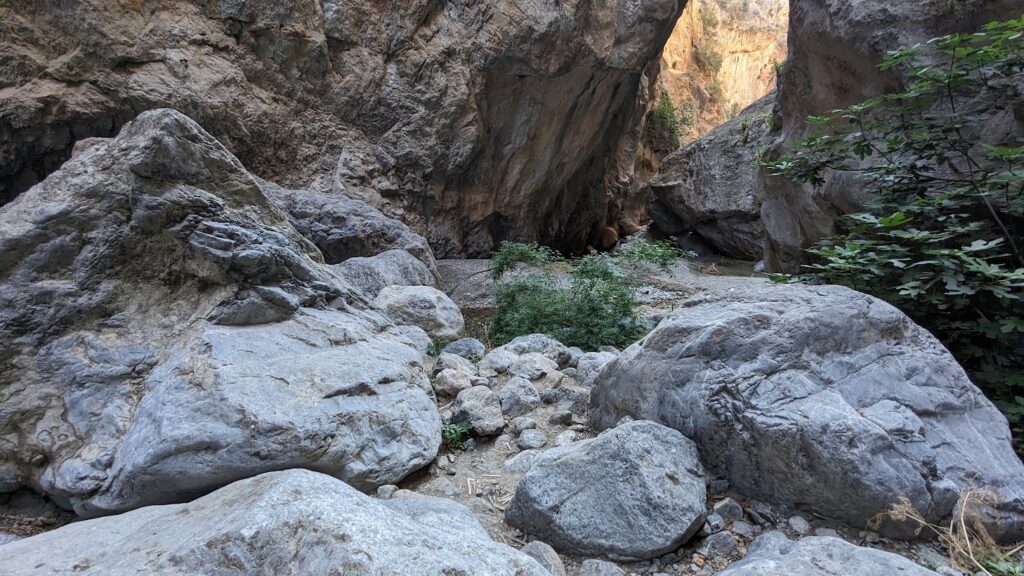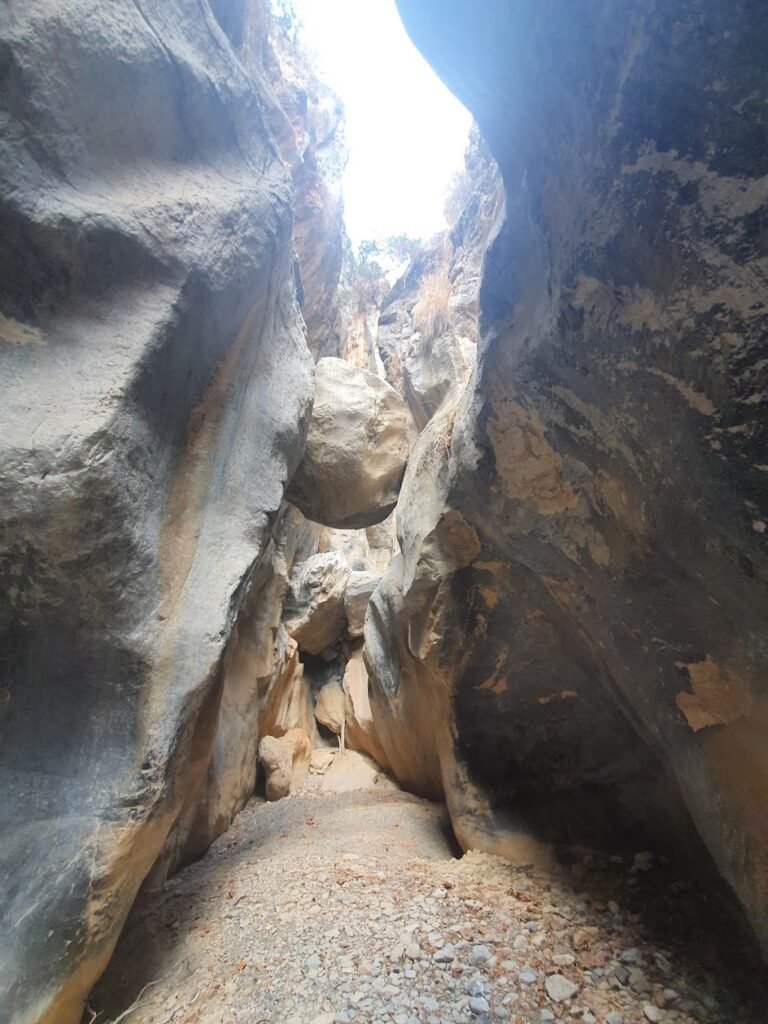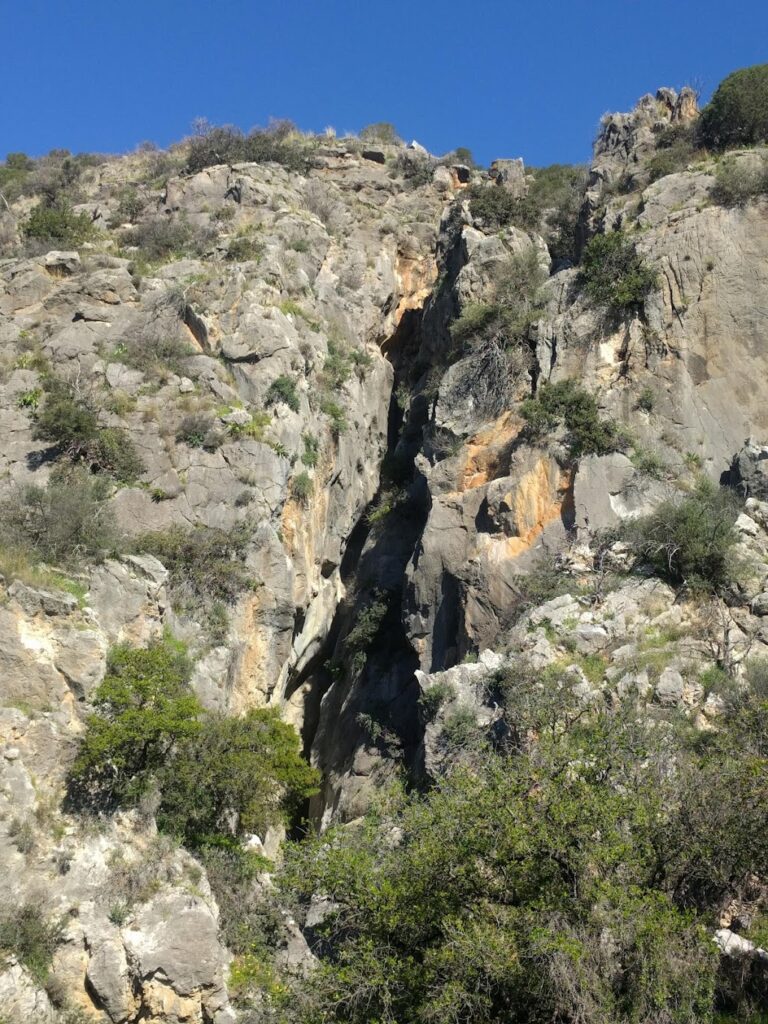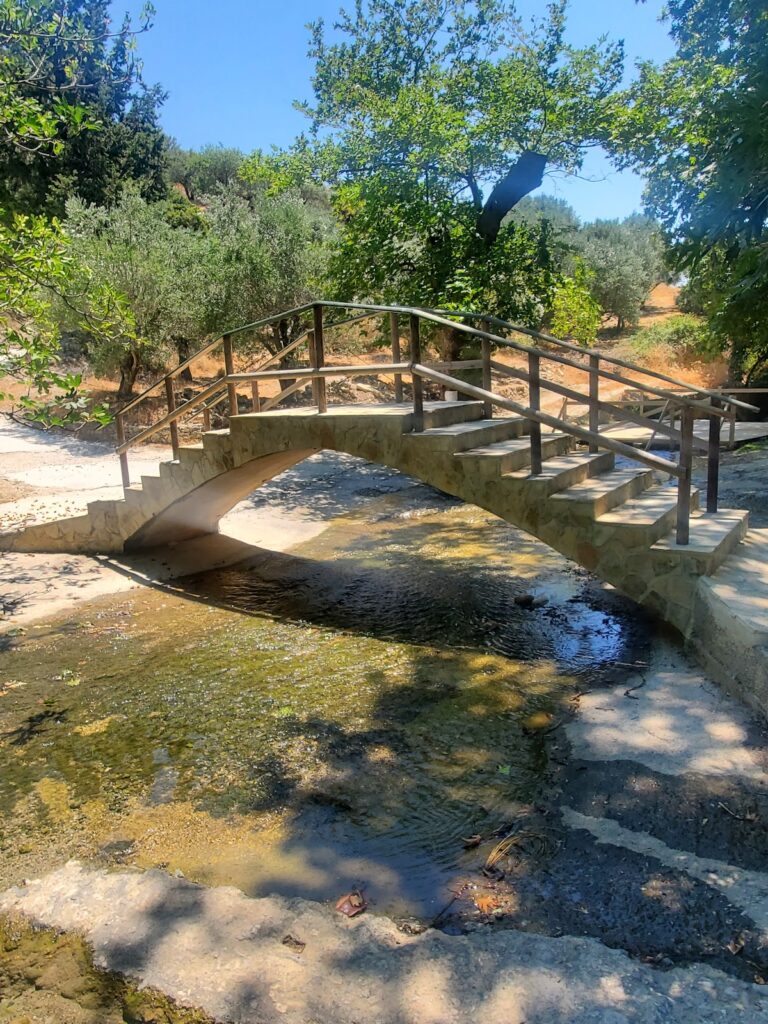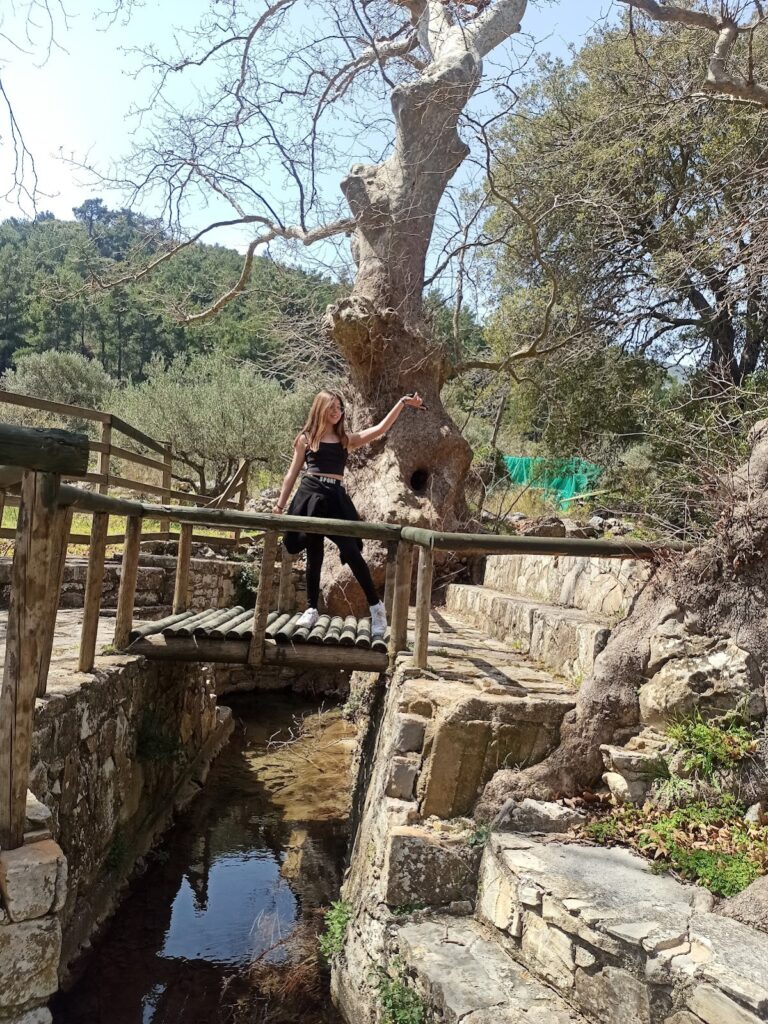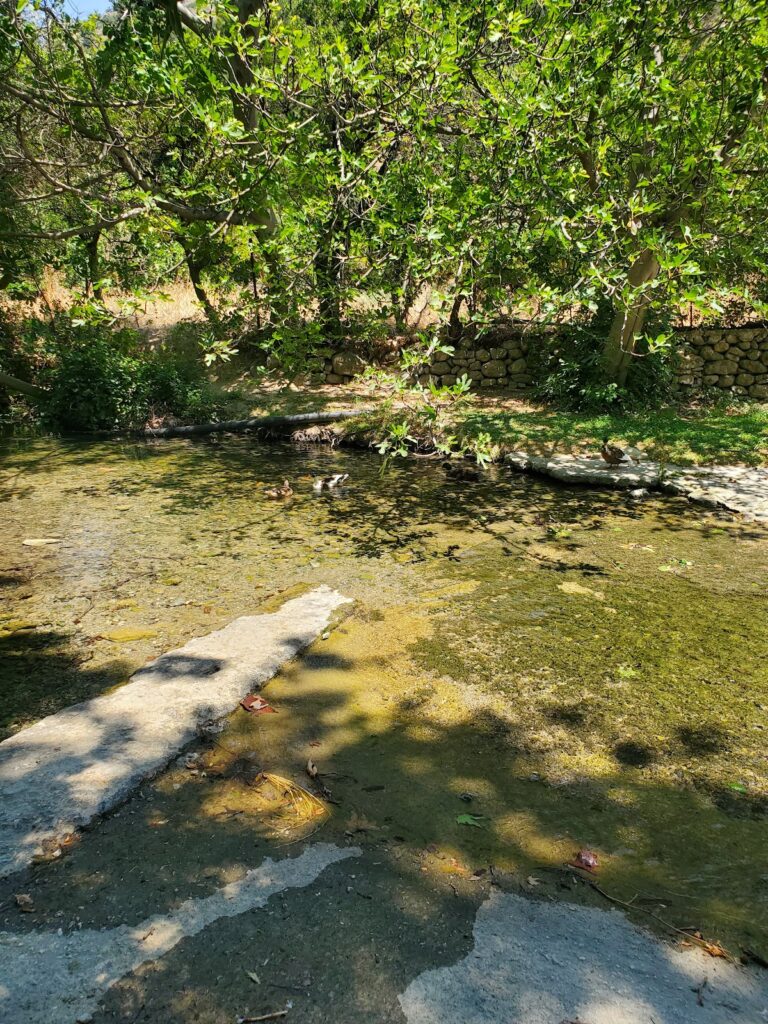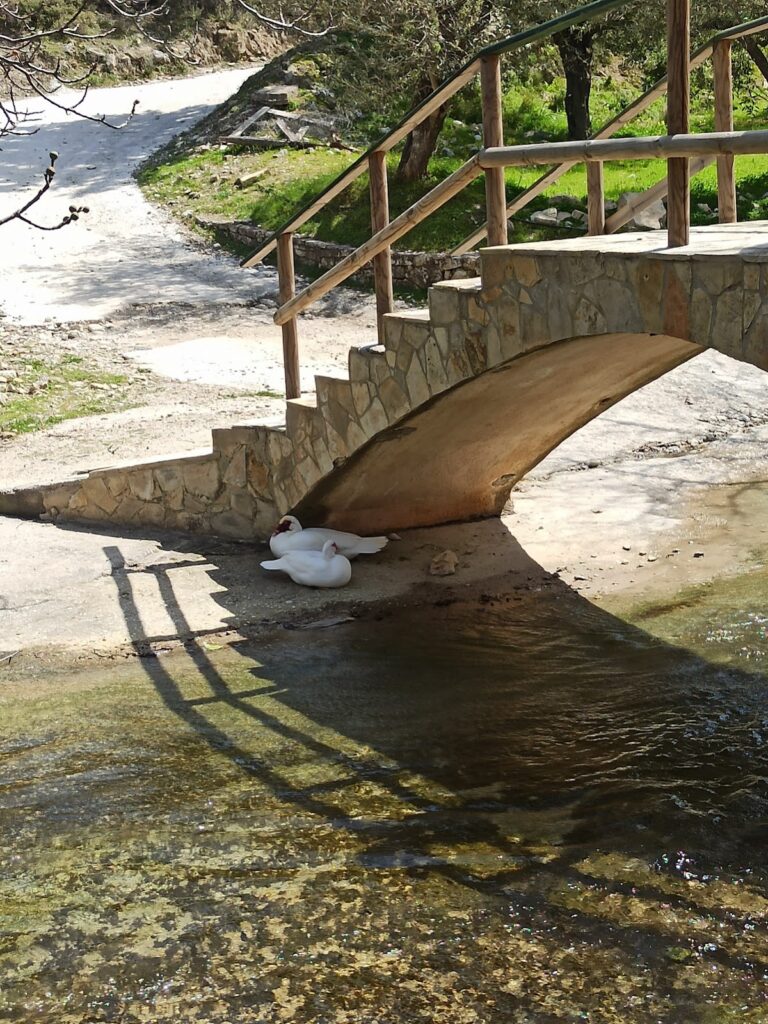Gorges to hike and walk near Mírtos, in Lassithi region
List of Gorges near Mírtos
- 1.1 km
- Sarakina Gorge
- 1.5 km
- 1 h
- Hiking
This magnificent natural phenomenon – Sarakina Gorge – can be found near the traditional village of Mythi and the coastal settlement of Myrtos, where the Kryos river merges with the sea.
As the tale goes in Greek mythology, Zeus’s son, the giant Sarantapihos, once paused to quench his thirst from the Myrtos or Kryos river, near Ierapetra. His sweeping beard slashed the mountain, dividing it into two parts, thereby forming the Sarakina canyon.
Regarded by many visitors as Crete’s most captivating hiking gorge, Sarakina may only stretch 1.5km, but within this concise journey, one encounters an awe-inspiring spectacle of nature, a natural sculpture painstakingly crafted by water over countless years. The canyon boasts towering walls that rise up to 150m high and extremely narrow passages often found in technical gorges that require canyoneering equipment. The width of Sarakina fluctuates between 3 to 10 meters, rarely extending beyond these points.
The majority of the canyon is accessible to explorers of all abilities, featuring water, pools, and a handful of climbing points that necessitate careful navigation. A standout feature is the abundant water almost all year round, creating picturesque waterfalls and ponds perfect for a refreshing dip, even in the summer. In winter, traversing the gorge without getting soaked is a challenge. As one embarks on the route, they’ll encounter the need to climb, navigate immense boulders, and cross rocky bridges. Carved stone stairs and tree trunks are present in tricky spots to facilitate easier climbing.
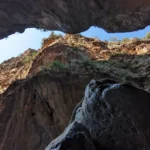
- 5.8 km
- Holy Apostles Gorge (Lapathos)
- 4 km
- 5 h
The Holy Apostles (Agii Apostoli) or Lapathos Gorge is situated on the southern part of Mount Dikti, 28km to the west of Ierapetra and 72km to the south of Heraklion, in the broader vicinity of the village of Kato Simi. This is a technical canyon, implying that crossing it necessitates technical gear and specific training. The Lapathos canyon is an ideal challenge for highly skilled canyoners. It spans approximately 4km and there is a height difference of about 900m between the start and finish points.
The canyon originates from the small plateau of Lapathos, where the Holy Apostles church stands, and concludes on the road that links the village of Pefkos with Ierapetra. Although it’s typically a dry canyon, in 2009, the team of seasoned canyoners Vassilis Vagias, Savvas Paragamian, and Giannis Skondinakis discovered it to contain surprisingly large amounts of water.
The gorge features 28 steep descents that demand excellent rappelling skills. The tallest rappel is 80m, making it one of the highest in all of Crete. The sheer walls of Lapathos serve as nesting grounds for a variety of birds including vultures, hawks, and crows. Towards the gorge’s exit, the vegetation is predominantly made up of pines and cypresses. Following the exit, the stream continues its journey to Tertsa beach.

- 8.1 km
- Panagia Keralimeniotissa Gorge
- 0.6 km
- 1.5 h
- Canyoneering equipment needed
Also known as Kalami I, the Panagia (Virgin Mary) Canyon runs in parallel to the Xerofarago Gorge, or Kalami II. It’s named after the Panagia Keralimeniotissa Monastery, which used to be located at the canyon’s exit. This canyon is technical, meaning it features steep descents and requires special canyoning gear to traverse. Spanning roughly 600 meters, the canyon includes six rappels, the highest of which is about 15 meters. It’s rich in vegetation and has a distinct beauty. The riverbed holds water until spring. Crete’s speleological clubs have bolted the canyon, and a small canyoning group can navigate it in about 1:30 hours.
If you’re planning to use two cars and park them at the canyon’s entrance and exit, the distance between the two parking spots is around 2.5 km or a 10-minute drive. Alternatively, you can reach the entrance by walking along the canyon walls for approximately 20-25 minutes.
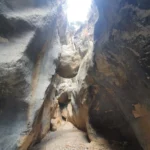
- 9.7 km
- Havgas Gorge (Kalamafka)
- Hiking
The Havgas Gorge, situated near the village of Kalamafka and just 12km north of Ierapetra city, is one of several gorges with the same name scattered across Crete. Other examples include the Havgas Gorge in the Lassithi Plateau, Plaka, and Kavoussi. The Havgas Gorge is nestled between the Megali Korfi (1103m) and Kokies (993m) peaks, and its stream, the Kapsous, serves as the primary tributary of the Kalamavkianos River that empties into the Stomio beach of Gra Ligia.
This stunning canyon boasts unique rock formations, sculpted by rare geological events. Many of these rocks are adorned with nature’s own “artwork”, etched over time by the elements. Despite its relatively short length, the gorge offers an easy and enjoyable walk along the riverbed, even for novices. The area’s altitude of around 500m provides the perfect environment for a lush pine forest. Regrettably, repeated fires have caused the forest to diminish in size. Nevertheless, the area is worth a visit, and visitors are sure to be charmed by the sight of small pine trees sprouting from the rocks, akin to bonsai trees.
The gorge’s depth extends to 300m. At one spot, two narrow rocks form the entrance to a series of caves that served as a refuge for Cretan rebels and Allies during the German Occupation. The locals refer to this area as the “Chinese Landscape”, due to the smooth rocks dotted with bonsai-like trees. Adjacent to the gorge’s exit, visitors can explore the village of Kalamafka with its inviting taverns and babbling water. Additionally, nearby attractions include an ancient olive oil mill and the churches of Saint John and Saint Anthony.

- 11.6 km
- Arvi Gorge
- 2 km
- 2.5 h
Crete is home to numerous stunning locations, but a select few can truly be classified as natural marvels. One such marvel is the Arvi gorge, which dramatically splits Arvion Mount in two. This is the location where the shrine of Zeus Arveios once stood. The Arvi and Cha gorges are considered the most awe-inspiring canyons in Crete. The Arvi gorge can be found to the north of the coastal village of Arvi, in the southern region of the Heraklion prefecture, and it has been carved out of the limestone of Mount Dikti.
This gorge is technical in nature, meaning it necessitates canyoning equipment and flashlights to navigate due to the presence of numerous waterfalls in succession. It is a truly perilous area, and any attempts to cross it by those unaccustomed to canyoning could result in tragedy. From winter until the onset of summer, the canyon is filled with water, which adds to its awe-inspiring beauty. The majority of this water originates from the perennial springs of Kefalovrysi. The Arvi gorge presents a high level of difficulty.
The entrance to the gorge is located in the Konisma (Icon) forest, named after a rock that resembles an icon of Christ. The gorge stretches across the Fournos area and features numerous descents, the most remarkable of which is an astounding 85-meter waterfall named Kapnistis (Smoker). This waterfall is named for its smoke-like water spray, which is a result of its incredible height. Kapnistis is one of Crete’s tallest and most impressive waterfalls. However, what truly sets this canyon apart from others in Greece is the section after the high rappel of Kapnistis, where the river flows into the earth for 150 meters, forming an underground river within a cave. In this underground section, the river continues to form waterfalls. Lighting equipment is necessary to navigate this completely dark area. After this dark section, the gorge remains incredibly narrow with extraordinary formations and large rocks, known as splines, beneath which we pass.
Following approximately 20 waterfalls, the gorge concludes and leads to the fertile plains of Arvi, renowned for their banana crops, and situated next to the monastery of Saint Anthony (Agios Antonios). The area at the gorge’s exit is humorously named Donkey’s Ass! In ancient times, a bountiful water spring existed here, but it has since dried up due to the construction of wells. This natural wonder has been a popular attraction for travelers since ancient times. The gorge’s river ends in the South Cretan Sea, but the water never reaches the sea due to its use for irrigation.
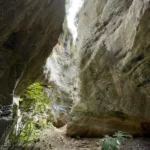
No results available
ResetGorges in other nearby areas
No results available
Reset